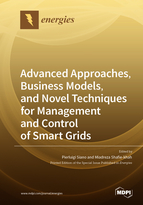Advanced Approaches, Business Models, and Novel Techniques for Management and Control of Smart Grids
A special issue of Energies (ISSN 1996-1073). This special issue belongs to the section "A1: Smart Grids and Microgrids".
Deadline for manuscript submissions: closed (31 March 2020) | Viewed by 40438
Special Issue Editors
Interests: smart grids; energy management; power systems; demand response
Special Issues, Collections and Topics in MDPI journals
Interests: smart grid; demand response; electric vehicle; power system; electricity market
Special Issues, Collections and Topics in MDPI journals
Special Issue Information
Dear Colleagues,
We invite submissions to a Special Issue of Energies on the subject of advanced approaches, business models, and novel techniques for the management and control of smart grids. The current power system should be renovated to fulfill social and industrial requests and economic advances. Hence, providing economic, green, and sustainable energy are key goals of advanced societies. In order to meet these goals, recent features of smart grid technologies need to have the potential to improve reliability, flexibility, efficiency, and resiliency. This Special Issue aims to encourage researchers to address the mentioned challenges.
Topics of interest for publication include but are not limited to the following:
- The design, modeling, and management of smart grids;
- System reliability, sustainability, flexibility, and resiliency;
- Methodologies and applications of modern methods for the operation and control of smart grids;
- Intelligent systems, solving methods, optimization, and advanced heuristics;
- The modeling, planning, and operating of renewable energy resources;
- Business models for different electricity market players;
- Demand side management and demand response;
- The sizing, placement, and operation of energy storage systems and electric vehicles;
- Smart homes and building energy management;
- Electricity market, electrical power, and energy systems;
- The modeling, forecasting, and management of uncertainty in smart grids;
- Microgrids and islanded networks;
- Smart cities, smart energy, and IoT.
Prof. Dr. Pierluigi Siano
Prof. Dr. Miadreza Shafie-khah
Guest Editors
Manuscript Submission Information
Manuscripts should be submitted online at www.mdpi.com by registering and logging in to this website. Once you are registered, click here to go to the submission form. Manuscripts can be submitted until the deadline. All submissions that pass pre-check are peer-reviewed. Accepted papers will be published continuously in the journal (as soon as accepted) and will be listed together on the special issue website. Research articles, review articles as well as short communications are invited. For planned papers, a title and short abstract (about 100 words) can be sent to the Editorial Office for announcement on this website.
Submitted manuscripts should not have been published previously, nor be under consideration for publication elsewhere (except conference proceedings papers). All manuscripts are thoroughly refereed through a single-blind peer-review process. A guide for authors and other relevant information for submission of manuscripts is available on the Instructions for Authors page. Energies is an international peer-reviewed open access semimonthly journal published by MDPI.
Please visit the Instructions for Authors page before submitting a manuscript. The Article Processing Charge (APC) for publication in this open access journal is 2600 CHF (Swiss Francs). Submitted papers should be well formatted and use good English. Authors may use MDPI's English editing service prior to publication or during author revisions.
Keywords
- electrical power and energy systems
- smart city
- smart grid
- control, management







